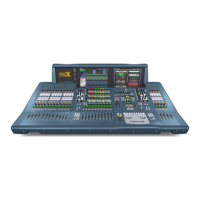13Quick Start Guide
Control Surface
The control surface is divided into areas whose function is, largely, dependent on
bay location. Each bay has assorted control elements with local feedback and/or
support from the two centrally located GUI display screens. The screens can be
controlled remotely via external VGA connections, and third party systems can
also be viewed/controlled via an integrated KVM switch on the rear panel.
A — input fast zone: 16 input fast strips across the 12-channel and 4-channel
input bays provide the operator’s ‘must have now’ controls.
B — channel strip and mixes: processing areas, such as the D-zone (dynamic),
E-zone (EQ) and mix controls, provide a more comprehensive control by allowing
detailed adjustments to a single channel’s audio parameters.
C — channel and bus navigation zone: sections for channel and bus navigation
and selection. For details, see Navigation.
D — output fast zone: the new output-centric centre section, allows
the simultaneous display of 24 mono or stereo mix buses, and advanced
navigation buttons.
E — VCA and POP groups: VCA faders and POP group sections.
F — miscellaneous: master channel strips, A and B signal path monitoring,
communications, I-zone, surround monitoring and mute groups.
G — primary navigation zone: trackballs for mix and master bay GUI screen
control, and a screen access panel (between trackballs) for direct access to GUI
menu options.
H — automation: scene store/recall and system edit.
ACEHGCA
BD F B

